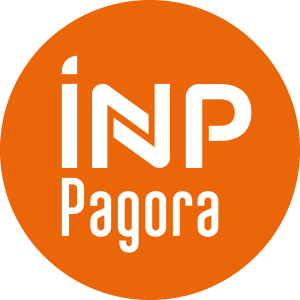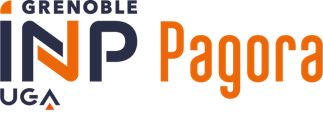Volumes horaires
- CM 7.5
- Projet -
- TD -
- Stage -
- TP -
- DS 3.0
Crédits ECTS
Crédits ECTS 16.0
Objectif(s)
Acquis de l'apprentissage :
- Connaître la problématique de l'électronique imprimée (matériaux, évolution des publications, brevets, congrès pour les secteurs des oleds, batteries, RFID et cellules photovoltaïques...)
- Comprendre le système photoluminescent pour la sécurisation de document
- Comprendre les piles à combustible, l'impression de pistes conductrices base cuivre, les cellules photovoltaïques, et les électrodes pour batteries Li-ion
Didier CHAUSSY
Contenu(s)
Présentation des différentes applications intégrant la problématique de l'électronique imprimée.
Encres, supports d'impression et procédés pour l'élaboration de systèmes fonctionnelles
Introduction et Généralités (Matériaux organiques conducteurs, évolution des publications, brevets, congrès pour les secteurs des oleds, batteries,RFID et cellules photovoltaïques...)
Système photoluminescent pour sécurisation de document
Application piles à combustible
Impression de pistes conductrice base cuivre
Application cellules photovoltaïques
Application électrodes pour batteries Li-ion
cours encres, rhéologie et procédés d'impression
Accessibilité des personnes en situation de handicap : nous consulter
- Crédits spécifiques : ce cours compte pour 1.0 ECTS pour les étudiants en Digital Printing and Printed electronic
Examen écrit
DS commun avec "Electronique imprimée : Matériaux"
Matière Rattrapable
- modalités si les conditions sont normales : DS en temps limité
- modalités en conditions dégradées (crise sanitaire covid) : DM en temps limité)
Cours : Note de DS
Le cours est programmé dans ces filières :
- Cursus ingénieur - Parcours internationaux - Semestre 8
- Cursus ingénieur - Ingenieur Pagora - Statut CFA - Semestre 8
- Cursus ingénieur - Ingenieur Pagora - Statut Etudiant - Semestre 8
Code de l'enseignement : 4FMT1116
Langue(s) d'enseignement : 
Vous pouvez retrouver ce cours dans la liste de tous les cours.
Sécurité-Environnement
Rien de particulier concernant le déroulement du cours : salle de cours standard
Sécurité : RAS
Environnement : RAS
Exemple de bibliographie :
[1] Huebler, A., Hahn, U., Beier, W., Lasch, N., Fischer, T., 2002. High Volume Printing Technologies for the Production of Polymer Electronic Structures, dans “2nd Int IEEE Conference on Polymers and Adhesives in Microelectronics and Photonics”, Zalaegerszeg, p 172.
[2] D.Tobajörk,R.österbacka., 2011. Paper Electronics. Adanced materials, 23, 1935-1961.
[3] Jolke Perelaer, Patrick J. Smith, Dario Mager, Daniel Soltman, Steven K. Volkman, Vivek Subramanian, Jan G. Korvink, Ulrich S. Schubert, Printed electronics : the challenges involved in printing devices, interconnects, and contacts based on inorganic materials, 2010, disponible sur le site du journal ‘The Royal society of Chemistry’ : www.rsc.org/materials.
[4] D.T Britton, Märting, D. Knosen, Z. Sigcau, F.P Nemalili, T.P. Ntsoane, P.Sperr, W. Egger, M.Nippus, thin solid films 2006, 501, 79-83
[5] Technifilm, Films destinés à l’industrie graphique et l’électronique imprimée, [en ligne] Site disponible sur : http://www.technifilm.com/Electronique-imprimee.html (consulté le 10/10/2014)
[6] De Gans, B-J., Schubert, US., 2004. Inkjet Printing of Well Defined Polymer Dots and Arrays. Langmuir., 20, 7789-7793.
[7] D. Deneganello, J.A. Cherry, D.T. Claypole, 2011, Impact of metered ink volume on reel-to-reel flexographic printed conductive networks for thin film conductivity, Welsh Centre for Printing and Coating, College of Ingineering, Sweansea university, Singleton Park, United Kingdom.
[8] Vivek Subramanian, Jean M. J. Fréchet, Paul C. Chang, Daniel C. Huang, Joséphine B. Lee, Steven E. Molesa, Amanda R. Murphy, David R. Redinger et Steven K. Volkman, Progress Toward Development of All-Printed RFID Tags : Materials, Processes, and Devices, Proceedings of the IEEE, Vol. 93, n°7, July 2005, 1330-1338
[9] Geyer, U., Siegel, F., Kreutzer, A., Blaudeck, T., Baumann, R. R., 2009. Printing electrode materials for rechargeable lithium thin-film batteries, dans “LOPE-C 2009: The Future of Organic and Printed Electronics”, édité par , Institute for Print and Media Technology, Chemnitz.
[10] Berend-Jan de Gans, Paul C. Duineveld, Ulrich S. Schubert, Inkjet printing of polymers : State of the art and future developments, No. 3, February 2004, Advanced materials
[11] Arjowiggins, présentation du papier Powercoat® ALIVE [en ligne] Site disponible sur : http://powercoatpaper.com/powercoat/alive/ (consulté le 11/02/2015)
[12] Markus Hösel, Roar R. Søndergaard, Dechan Angmo and Frederik C. Krebs, Comparison of Fast Roll-to-Roll Flexographic, Inkjet, Flatbed, and Rotary Screen Printing of Metal Back Electrodes for Polymer Solar Cells, Advanced engineering materials, vol 15, N°10, 2013.



